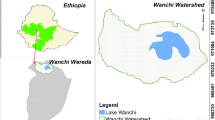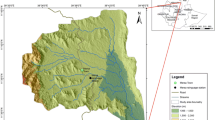Abstract
Understanding the complexity of land-use and land-cover (LULC) changes and their driving forces and impacts on human and environmental security is important for the planning of natural resource management and associated decision making. This study combines and compares participatory field point sampling (pfps) and remote sensing to explore local LULC dynamics. The study was conducted in two peasant associations located in the central Ethiopian Rift Valley, which is a dry-land mixed farming area exposed to rapid deforestation. From 1973–2006, the area of cropland doubled at the expense of woodland and wooded-grassland in both of the study sites. Major deforestation and forest degradation took place from 1973–1986; woodland cover declined from 40% to 9% in one of the study sites, while the other lost all of its original 54% woodland cover. Our study concludes that assessing LULC dynamics using a combination of remote sensing and pfps is a valuable approach. The two methods revealed similar LULC trends, while the pfps provided additional details on how farmers view the changes. This study documents dramatic trends in LULC over time, associated with rapid population growth, recurrent drought, rainfall variability and declining crop productivity. The alarming nature of these trends is reflected in a decrease in the livelihood security of local communities and in environmental degradation. Given these dry-land conditions, there are few opportunities to improve livelihoods and environmental security without external support. If negative changes are to be halted, action must be taken, including building asset bases, instituting family planning services, and creating opportunities outside these marginal environments.




Similar content being viewed by others
References
Amente G, Huss J, Tennigkeit T (2006) Forest regeneration without planting: the case of community managed forests in the Bale Mountains of Ethiopia. Journal of the Drylands 1:26–34
Appelgren B (2009) Towards sustainable dryland development in Africa: integrating ground water and land management. In: Schaa T, Lee C (eds) The future of drylands. Springer, New York, pp 199–208
Appiah M, Blay D, Damnyag L, Dwomoh F, Pappinen A, Luukkanen O (2007) Dependence on forest resources and tropical deforestation in Ghana. Environment, Development and Sustainability. doi:10.1007/s10668-007-9125-0
Argaw M, Teketay D, Olsson M (1999) Soil seed flora, germination and regeneration pattern of woody species in Acacia woodland of the Rift Valley in Ethiopia. Journal of Arid Environments 43:411–435
Ayalew D, Dercon S, Gautam M (2005) Property rights in a very poor country: tenure insecurity and investment in Ethiopia. WPS-021, Global Poverty Research Group (GPRG)
Barrett CB, Reardon T, Webb P (2001) Nonfarm income diversification and household livelihood strategies in rural Africa: concepts, dynamics, and policy implications. Food Policy 26:315–331
Bekele M (2003) Forest property rights, the role of the state, and institutional exigency: the Ethiopian experience. PhD Thesis. Department of Rural Development Studies, Swedish University of Agricultural Sciences, Uppsala
Berg MVD, Earo KG (2006) Poverty and the rural nonfarm economy in Oromia, Ethiopia. Agricultural Economics 35:469–475
Bogale A, Taeb M, Endo M (2006) Land ownership and conflicts over the use of resources: implication for household vulnerability in eastern Ethiopia. Ecological Economics 58:134–145
Boserup E (1965) The conditions of agricultural growth: the economics of agrarian change under population pressure. G. Allen and Unwin, London
Birch-Thomsen T, Frederiksen P, Sano H-O (2001) A livelihood perspective on natural resource management and environmental change in semiarid Tanzania. Economic Geography 77:41–66
Campbell JB (2002) Introduction to remote sensing. Taylor & Francis, London
Campbell BM, Sayer JA, Frost P, Vermeulen S, Ruiz-Pérez M, Cunningham AB, Prabhu R (2001) Assessing the performance of natural resource systems. Conservation Ecology 5:22. http://www.consecol.org/vol5/iss2/art22/. Accessed 2 Jan 2009
Central Statistical Agency (CSA) (2006) National population statistics. Federal Democratic Republic of Ethiopia, Central Statistical Authority, Addis Ababa
Cheng S, Hiwatashi Y, Imai H, Naito M, Numata T (1998) Deforestation and degradation of natural resources in Ethiopia: forest management: implications from a case study in the Belete-Gera forest. Journal of Forest Research 3:199–204
Chen L, Wang J, Fu B, Qiu Y (2001) Land-use change in a small catchment of northern Loess Plateau, China. Agriculture, Ecosystems & Environment 86:163–172
Crewett W, Bogale A, Korf B (2008) Land tenure in Ethiopia: continuity and change, shifting rulers, and the quest for state control. CAPRi Working Paper 91. International Food Policy Research Institute, Washington, DC
Darbyshire I, Lamb H, Umer M (2003) Forest clearance and regrowth in Northern Ethiopia during the last 3000 years. The Holocene 13:537–546
Demeke M, Kelly V, Jayne TS, Said A, Vallée JCL, Chen H (1998) Agricultural market performance and determinants of fertilizer use in Ethiopia. Grain Market Research Project. Working Paper 10. Ministry of Economic Development and Cooperation, Addis Ababa
de Sherbinin A (2002) Land-use and land-cover change, a CIESIN thematic guide. Center for International Earth Science Information Network of Columbia University, Palisades, NY. http://sedac.ciesin.columbia.edu/tg/guide_frame.jsp?rd=LU&ds=1. Accessed 20 May 2006
Dessie G, Christiansson C (2008) Forest decline and its causes in the South-Central Rift Valley of Ethiopia: human impact over a one hundred year perspective. Ambio 37:263–271
Dessie G, Kleman J (2007) Pattern and magnitude of deforestation in the South Central Rift Valley region of Ethiopia. Mountain Research and Development 27:162–168
Devereux S (2000) Food insecurity in Ethiopia. A discussion paper for DFID. Institute of Development Studies, Sussex
Dhakal M (2008) Roger sands, forestry in a global context, CABI Publishing, Wallingford UK (2005) ISBN 978-0851990897, 262 pp. Forest Policy and Economics 10:428–429
FAO (2005) Global forest resources assessment 2005. Progress towards sustainable forest management. FAO forestry paper 147. Food and Agriculture Organization of the United Nations, Rome. http://www.fao.org/forestry/fra2005/en/. Accessed 26 Dec 2006
FAO (2007) State of the world’s forests 2007. Food and Agriculture Organization of the United Nations, Rome. http://www.fao.org/docrep/009/a0773e/a0773e00.HTM. Accessed 2 Jan 2008
Farm-Africa/SOS Sahel Ethiopia (2007) Participatory Forest Management (PFM): biodiversity and livelihoods in Africa. In: Kelbessa E, Stoop CD (eds) Proceedings of the international conference 19–21 Mar 2007, Addis Ababa, Ethiopia, 288 pp
Frost P, Campbell B, Luckert M, Mutamba M, Mandondo A, Kozanayi W (2007) In search of improved rural livelihoods in semi-arid regions through local management of natural resources: lessons from case studies in Zimbabwe. World Development 35:1961–1974
Fuller DO, Chowdhury RR (2006) Monitoring and modelling tropical deforestation: introduction to the special issue. Singapore Journal of Tropical Geography 27:1–3
Gebremedhin B, Nega B (2005) Land and land policy in Ethiopia in the eyes of Ethiopian farmers: an empirical investigation. In: Ethiopian Economic Association (ed) Proceedings of second international conference on the Ethiopian economy, vol II. Addis Ababa, Ethiopia
Gebrekirstos A, Mitlöhner R, Teketay D, Worbes M (2008) Climate–growth relationships of the dominant tree species from semi-arid savanna woodland in Ethiopia. Trees - Structure and Function 22:631–641
Geist HJ, Lambin EF (2002) Proximate causes and underlying driving forces of tropical deforestation. BioScience 52:143–150
ICRA & EARO (2002) Food insecurity in a breadbasket: food security among households in the different agro-ecological zones in Arsi-Negelle Woreda, Ethiopia. Working Document Series 100 Ethiopia-2002, International Centre for Development Oriented Research in Agriculture (ICRA) & Ethiopian Agricultural Research Organization (EARO)
Jayne TS, Yamano T, Weber MT, Tschirley D, Benfica R, Chapoto A, Zulu B (2003) Smallholder income and land distribution in Africa: implications for poverty reduction strategies. Food Policy 28:253–275
Jorgenson AK, Burns T (2007) Effects of rural and urban population dynamics and national development on deforestation rates, 1990–2000. Sociological Inquiry 77:460–482
Kamusoko MA (2007) Land use/cover change and landscape fragmentation analysis in the Bindura District, Zimbabwe. Land Degradation & Development 18:221–233
Kassa H, Campbell B, Sandewall M, Kebede M, Tesfaye Y, Dessie G, Seifu A, Tadesse M, Garedew E, Sandewall K (2009) Building future scenarios and uncovering persisting challenges of participatory forest management in Chilimo Forest, Central Ethiopia. Journal of Environmental Management 90:1004–1013
Lambin EF, Geist HJ, Lepers E (2003) Dynamics of land-use and land-cover change in tropical regions. Annual Review of Environment and Resources 28:205–241
Liu J, Liu M, Tian H, Zhuang D, Zhang Z, Zhang W, Tang X, Deng X (2005) Spatial and temporal patterns of China’s cropland during 1990–2000: an analysis based on Landsat TM data. Remote Sensing of Environment 98:442–456
Liverman DM, Cuesta RMR (2008) Human interactions with the Earth system: people and pixels revisited. Earth Surface Processes and Landforms 33:1458–1471
Mather AS, Needle CL (2000) The relationships of population and forest trends. The Geographical Journal 166:2–13
Mayaux P, Bartholome E, Fritz S, Belward A (2004) A new land-cover map of Africa for the year 2000. Journal of Biogeography 31:861–877
Mekonnen A, Bluffstone R (2008) Is there a link between common property forest management and private tree growing? Evidence of behavioral effects from highland Ethiopia. Discussion Paper Series 08-29, Environment for Development (EfD) and Resource for the Future, 32 pp
Mundia CN, Aniya M (2006) Dynamics of landuse/cover changes and degradation of Nairobi City, Kenya. Land Degradation and Development 17:97–108
Nega B, Adenew B, GebreSelassie S (2003) Current land policy issues in Ethiopia. In: Groppo P (ed) Land reform: land settlements and cooperatives 2003/3, special edition. FAO, Rome, pp 103–124
Niehof A (2004) The significance of diversification for rural livelihood systems. Food Policy 29:321–338
Ningal T, Hartemink AE, Bregt AK (2008) Land use change and population growth in the Morobe Province of Papua New Guinea between 1975 and 2000. Journal of Environmental Management 87:117–124
Paré S, Söderberg U, Sandewall M, Ouadba JM (2008) Land use analysis from spatial and field data capture in southern Burkina Faso, West Africa. Agriculture, Ecosystems & Environment 127:277–285
Rembold F, Carnicelli S, Nori M, Ferrari GA (2000) Use of aerial photographs, Landsat TM imagery and multidisciplinary field survey for land-cover change analysis in the lakes region (Ethiopia). International Journal of Applied Earth Observation and Geoinformation 2:181–189
Sandewall M, Ohlsson B, Sawathvong S (2001) Assessment of historical land-use changes for purposes of strategic planning—a case study in Laos. Ambio 30:55–61
Smits PC, Dellepiane SG, Schowengerdt RA (1999) Quality assessment of image classification algorithms for land-cover mapping: a review and a proposal for a cost-based approach. International Journal of Remote Sensing 28:1464–1486
Sunderlin WD, Hatcher J, Liddle M. (2008) From exclusion to ownership? Challenges and opportunities in advancing forest tenure reform. Rights and Resources Initiative, Washington D.C. http://www.rightsandresources.org/documents/files/doc_736.pdf. Accessed 26 Jan 2009
Taddese G (2001) Land degradation: a challenge to Ethiopia. Environmental Management 27:815–824
Teketay D (2001) Deforestation, wood damine, and environmental degradation in Ethiopia’s highland ecosystems: urgent need for action. Northeast African Studies 8:53–76
Tekle K, Hedlund L (2000) Land cover changes between 1958 and 1986 in Kalu District, Southern Wello, Ethiopia. Mountain Research and Development 20:42–51
Tole L (2004) A quantitative investigation of the population-land inequality-land clearance nexus. Population & Environment 26:75–106
United Nations Population Division (2007) Population division of the department of economic and social affairs of the United Nations Secretariat, World Population Prospects. The 2006 revision. http://esa.un.org/unpp. Accessed 2 Oct 2007
WBISPP (2004) Forest resource of Ethiopia. Woody Biomass Inventory and Strategic Planning Project (WBISPP), Addis Ababa
Zeleke G, Hurni H (2001) Implications of land use and land cover dynamics for mountain resource degradation in the Northwestern Ethiopian highlands. Mountain Research and Development 21:184–191
Zhao S, Peng C, Jiang H, Tian D, Lei X, Zhou X (2006) Land use change in Asia and the ecological consequences. Ecological Research 21:890–896
Acknowledgments
The authors are thankful to Dr. Habtemariam Kassa, Dr. Mats Nilsson, Heather Reese, Neil Cory, Kefyalew Sahle and Mats Högström for their valuable time and contributions. We thank the farmers from the study area for their valuable participation and time. Special thanks go to Wondo Genet College of Forestry and Natural Resources, Department of Forest Resources Management (SLU) and the Swedish International Development Agency (SIDA) for financing the study. We thank also the three anonymous reviewers for helpful reviews on the manuscript.
Author information
Authors and Affiliations
Corresponding author
Rights and permissions
About this article
Cite this article
Garedew, E., Sandewall, M., Söderberg, U. et al. Land-Use and Land-Cover Dynamics in the Central Rift Valley of Ethiopia. Environmental Management 44, 683–694 (2009). https://doi.org/10.1007/s00267-009-9355-z
Received:
Revised:
Accepted:
Published:
Issue Date:
DOI: https://doi.org/10.1007/s00267-009-9355-z




